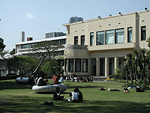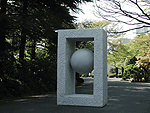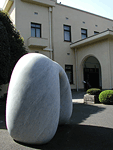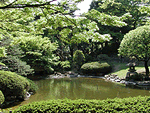While appearing like huge pearls Kan Yasuda's marble sculptures are made from patiently chipping away tonnes of stone. The marble Yasuda uses is translucent white and the fine dark veins running deep within the stone make it almost appear to be living. About ten of Kan Yasuda's sculptures are installed in the grounds of the Teien Art Museum. They form a triumphant gateway along the entrance road into the museum and are also scattered throughout the surrounding gardens.
Kan Yasuda was born in Bibai, Hokkaido and trained at Tokyo National University of Fine Arts and Music. He left Japan for Italy in 1970 on a fellowship for studies at the Academy of Arts in Rome. On completion of these studies he set up a studio at Pietrasanta in northern Italy. This region is world renowned as the source of the most favored marble for sculpture. Five hundred years ago Michelangelo used the huge stones from Pietrasanta to carve some of history's most admired sculptures.
Yasuda's marble sculptures are spread around the world from Florence to Sydney. They have titles such as 'Ishinki', (life-stone) and 'Touchstone'. They are polished smooth as if they had tumbled for centuries down a huge river. However, Yasuda's massive stones appear soft, almost malleable, like the eggs of some great dinosaur. People are attracted to them, so that they may caress their silken polished surfaces. To touch them is to experience the geologic eons of time.
Other sculptures such as 'Tensei', 'Tenmoku' and 'Mamu' are very geometric. They are frames of stone through which to view his related works. These sculptures are finished in rough chipped marble, which reveal the process of whittling these angular shapes from the raw rock. All of Yasuda's works are created through reduction -- the careful chipping away from huge stones. Some of the rock he uses is up to forty tonnes in weight. At times he carves them until less than half the original remains.
Yasuda's sculptures are on display in Tokyo for almost another year giving ample opportunity to visit the unique museum. Now designated a National Treasure the Teien Art Museum was originally built in 1933 as the residence for Prince Asaka and Princess Nobuko eighth daughter of the Emperor Meiji. Frenchman, Henri Rapin (1873-1939), designed the building in the Art Deco style.
Many of the interior fittings for the building were specially imported from France. However, the imperial household department carried out the basic plan of the building and the interior decoration. It is a remarkable building for the way it combines the linear elements of both Art deco and traditional Japanese architecture. The building is a synthesis of styles in which one part adds to the other. In 1983, after extensive restoration of the building, it was opened as an art museum. The title of the museum, Teien (park Ð garden), refers to the spacious green surrounds and its picturesque park-like setting. This verdant gem of seclusion in the midst of bustling Meguro district is a refreshing escape in any season.



